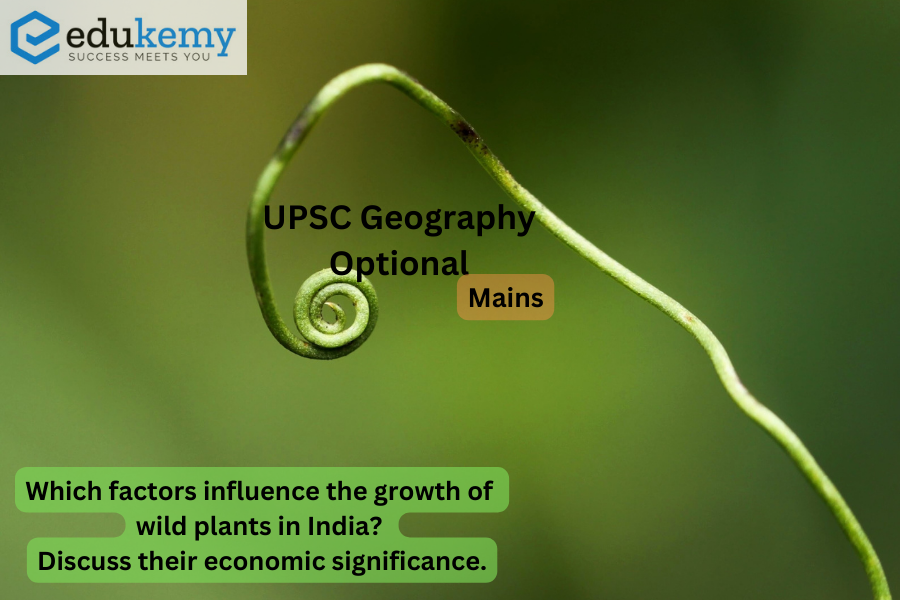Plant species that thrive and procreate in their native habitats without direct human interference are referred to as wild plants. In India, the growth of wild plants is deeply influenced by the nation’s varied physiography, spanning a wide range of topographies, soil types, and climates. Resultantly, India has a diverse spectrum of flora that has adapted to survive in a variety of environmental situations.
A multitude of factors influence the growth of wild plants in India which include:
- Climate variability influencing growth of wild plants: Diverse climate in India, influenced by varying monsoons, affects the growth of wild plants. Regions with adequate rainfall support lush vegetation while rainfall deficit areas support xerophytic vegetation. For example, heavy rainfall during the monsoon in the Western Ghats supports Nilgiri tahr grass (lemongrass), Malabar Rain Tree, and Neelakurinji. This influences agriculture, biodiversity, and tourism in this region.
- Different soil types supporting different wild plants: Different regions in India have varied soil types, affecting plant growth. For example, the fertile alluvial soils in the Gangetic plains support crops like rice and wheat, contributing to agricultural practices.
- Water Availability impacting growth of wild plants: Plants in India’s river basins, such as the Ganges and Brahmaputra, benefit from abundant water resources, influencing the growth of riparian vegetation and providing economic opportunities for local communities. For example, the Brahmaputra River basin in Assam sustains diverse plant life like Assam Tea, influencing the livelihoods of local communities and supporting cultural practices.
- Land use and agriculture practices impacting growth of wild plants: The expansion of agriculture and land-use practices (Agricultural Regions) can impact the growth of wild plants. For example, agroforestry practices in states like Kerala integrate wild plants like rubber trees, providing economic benefits through sustainable and diversified land use.
- Topography impacting growth of wild plants: The physical features of the land, including altitude, slope, and aspect, influence the distribution of plants. Certain species may be adapted to high-altitude regions, while others thrive in lowland areas. For example, Rhododendron arboretum in the Himalayas.
- Biotic Interactions impacting growth of wild plants: The interactions between plants and other living organisms, such as animals, insects, and fungi, can impact their growth. For example, many orchid species in India form mycorrhizal associations with fungi.
- Fire impacting growth of wild plants: In some ecosystems, periodic fires play a crucial role in shaping plant communities. Certain plant species may be adapted to withstand or even benefit from fire, while others may be negatively affected. For example, grass species like Imperata cylindrica (commonly known as cogon grass) in central India have adaptations that allow them to survive and even benefit from fire.

Contents
Economic Significance of Wild Plants in India:
- Medicinal Plants: The neem tree is widely known for its medicinal properties; neem leaves, bark, and seeds are used in traditional medicine for treating various ailments. Neem-based products, such as neem oil and neem-based pharmaceuticals, have economic value.
- Timber and Wood Products: Teak is a valuable timber species found wildly in various parts of India, economically important for its durable wood used in construction, furniture, and boat-building industries.
- Spices: Black pepper is a climbing plant native to the Western Ghats in India, historically cultivated for its peppercorns. The spice industry plays a significant role in the economy.
- Aromatic Plants and Essential Oils: The cultivation of aromatic Mentha arvensis for the production of menthol is an economically important activity.
- Wild Edible Plants: Bamboo shoots, sourced from various species of bamboo, are consumed as a traditional food in many parts of India. The collection and sale of bamboo shoots contribute to local economies, providing a source of income for communities.
Thus, wild plants play an important role in the economic development of a country. In India, schemes like the TRIFED initiative, the Minor Forest Produce Scheme, and the National Mission on Medicinal Plants are steps taken by the government to harness the economic potential of wild plants to the fullest.
To get free counseling/support on UPSC preparation from expert mentors please call 9773890604
- Join our Main Telegram Channel and access PYQs, Current Affairs and UPSC Guidance for free – Edukemy for IAS
- Learn Economy for free- Economy for UPSC
- Mains Answer Writing Practice-Mains Answer Writing
- For UPSC Prelims Resources, Click here

